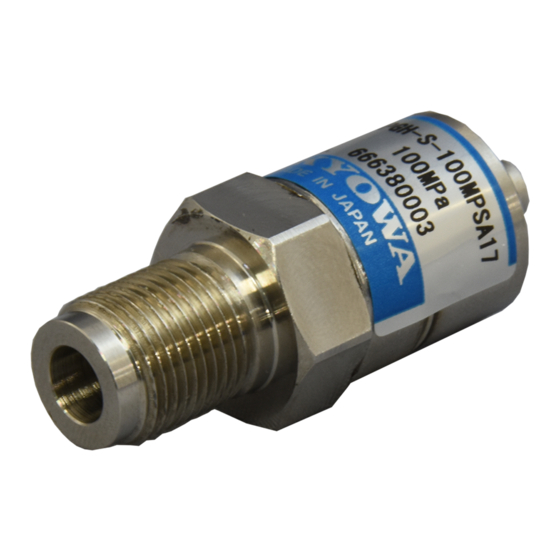
Advertisement
Quick Links
P G S -A Pressu re Tran sd u cers INSTRUCTION M ANUAL
Thank you for purchasing this KYOWA product. Before using it, read this
instruction manual carefully. Also, keep the manual within easy reach so
that you can refer to whenever necessary.
Specifications and dimensions described in this manual could be changed
without notice. Please visit our website for the latest version.
1. Calling the operator' s attention
The following cautionary symbols and headlines are used to invite the
operator' s attention. Be sure to observe the accompanying precautions in
order to safeguard the operator and preserve the performance of the
instrument.
Improper operation of the system may result in
W arning
severe injury of the operator.
Improper handling can cause deleterious effects to
Caution
the operator' s body
Cautions are given to invite the operator' s attention, in
Caution
order to avoid instrument failure or mal- function.
2. Im portant notice
Unless specified, the transducer must not be used under hydrogen
environment.
3. Safety precautions
Avoid pressure in excess of the allowable overload rating, or the
transducer may explode.
Avoid contact of a projecting object with the sensing surface, or the
latter may crack to result in the transducer' s explosion.
Use the specified tightening torque. Improper tightening torque may
cause the transducer' s explosion.
If excessive pressure could possibly occur, provide protective casing
around the transducer installation, in order to safeguard the operator.
Select sufficiently strong material for mounting screw hole.
Dismount the transducer only after the applied pressure has been
completely removed.
SUS630 (JIS G4303) is used where the transducer contacts a liquid.
Avoid application of the instrument to a corrosive liquid or gas.
4. Handling precautions
Do not disassemble the transducer.
Take care to keep the mount screw from damages.
Protection code is IP52. It should not be used underwater.
No condensing. If it formed condensation, immediately dry.
Avoid pressure on the casing.
The pressure transducer can not be used in vacuum environments.
Keep foreign matters from entering the two holes on the top of casing.
Do not bend the cable at its outlet.
Make sure that the bending radius of cable is longer than 6 times of
a diameter of the cable.
In vibration environment, fix the cable at its outlet and required
portions. Even if the cable is fixed at a distance shorter than 30cm
from the pressure transducer, vibration acceleration should be below
147m/ s
(Approx.15G).
2
W arning
Caution
Caution
If the rising time of the dynamic phenomenon to be measured is short,
the total response including the transducer and measuring instrument
in use may be problem.
Before measurement, check their specifications.
5. Mounting
5.1 Using a gasket, mount the transducer. Apply your spanner to the
spanner rest on the connecting screw section or the transducer may be
damaged. Also, turn the cable together to protect the cable from
damage due to twisting.
・ Tightening torque is 60 to 100 N- m.
5.2 Use a new gasket.
5.3 Mount the transducer possibly closest to the pressure source.
5.4 When conduit is used, install a cock or valve between the conduit and
connection portion to easily mount and demount the wire conduit.
6. Connection
6.1 Connect the transducer to a measuring instrument.
6.2 When using a measuring instrument other than KYOWA, connector
plug as follows.
When connected the attached cable, shield wire is not connected to
the case.
6.3 Heat run for 5 minutes or longer before starting the measurement.
IM-T-168J J ul 2022
Advertisement

Summary of Contents for KYOWA PGS-A
- Page 1 IM-T-168J J ul 2022 P G S -A Pressu re Tran sd u cers INSTRUCTION M ANUAL Thank you for purchasing this KYOWA product. Before using it, read this If the rising time of the dynamic phenomenon to be measured is short, instruction manual carefully.
- Page 2 Provided that the connector operates properly and that the insulation to the case.) resistance between the mainframe and conductors is below 100MΩ , the cause may be failure of the conversion element. In this case, contact your KYOWA representative. ◆ Mechanical Properties Safe Overloads 150%...
- Page 3 IM-T-168J 2022.7 P G S -A 型 圧力変換器-取扱説明書 動的現象での立ち 上がり 時間が短い場合は,変換器と 測定器 こ のた びは本製品を お買い上げいた だき ま し て ,あ り がと う ご を 含めた 応答性が問題にな り ま す。各々の応答性を 確認の上 ざ いま す。 ご 使用の前には, 本書を 必ずお読みく ださ い。 ま...
- Page 4 ( 注) RoH S 指令対応品は,C Eマーク の表記付き 製品に限り ま す。 絶縁抵抗を 測定する 場合, 絶縁抵抗計の印加電圧は50V以 ◆付属品 下で行っ て く ださ い。 ガス ケ ッ ト ( 軟銅) 3 個 付属ケ ーブル 1 本 検査成績書 1 部 取扱説明書 1 部( 本書) ホ ーム ページ ア ド レ ス www.kyowa-ei.com...















Need help?
Do you have a question about the PGS-A and is the answer not in the manual?
Questions and answers